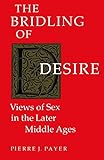The bridling of desire : views of sex in the later Middle Ages / Pierre J. Payer.
Material type: TextPublication details: Toronto [Ont. : University of Toronto Press, (c)1993.Description: 1 online resource (vi, 285 pages)Content type:
TextPublication details: Toronto [Ont. : University of Toronto Press, (c)1993.Description: 1 online resource (vi, 285 pages)Content type: - text
- computer
- online resource
- 9781442671577
- BT708 .B753 1993
- COPYRIGHT NOT covered - Click this link to request copyright permission: https://lib.ciu.edu/copyright-request-form
- digitized 2010 HathiTrust Digital Library committed to preserve
| Item type | Current library | Collection | Call number | URL | Status | Date due | Barcode | |
|---|---|---|---|---|---|---|---|---|
 Online Book (LOGIN USING YOUR MY CIU LOGIN AND PASSWORD)
Online Book (LOGIN USING YOUR MY CIU LOGIN AND PASSWORD)
|
G. Allen Fleece Library ONLINE | Non-fiction | BT708 (Browse shelf(Opens below)) | Link to resource | Available | ocn244767770 |
Includes bibliographies and index.
The later Middle Ages saw the emergence of an integral theory of human sexuality, a systematic account of its origins, role, and significance in the divine plan. Instead of simply dismissing medieval views of sex as misogynist and guilt-ridden, Pierre Payer urges a re-examination of medieval writers' understanding of sexuality within the context of their cosmological perspective. He traces the developing consensus about what was thought to be the nature, purpose, and morality of sex as conceived by writers and theologians during this period. Concentrating on the positive dimension of medieval thought on sexuality, Payer first examines views on Paradise, the Fall, and original sin and its transmission. There follows an extended discussion of marriage as the sole outlet for legitimate sexual intercourse. He then turns to the broader question of the control of sexual impulses and desires through the virtue of temperance. The book concludes with a description of the virtue of virginity, which was seen to be the apex of temperance and the ideal of Christian living. Payer has assembled a vast number of textual sources from the late medieval period, presenting to the reader a variety of opinions, their development, and underlying presuppositions.
COPYRIGHT NOT covered - Click this link to request copyright permission:
https://lib.ciu.edu/copyright-request-form
Master and use copy. Digital master created according to Benchmark for Faithful Digital Reproductions of Monographs and Serials, Version 1. Digital Library Federation, December 2002. MiAaHDL
http://purl.oclc.org/DLF/benchrepro0212
digitized 2010 HathiTrust Digital Library committed to preserve pda MiAaHDL
""Contents""; ""Acknowledgments""; ""Abbreviations""; ""Introduction""; ""1 Paradise""; ""Gender Difference""; ""Reproduction through Intercourse""; ""Semen""; ""Pleasure""; ""Procreation""; ""Virginity""; ""Sexual Relations in Paradise?""; ""2 The Fall, Original Sin, and Concupiscence""; ""Temptation and the First Sin""; ""Original Sin""; ""Sensuality and First Movements""; ""Lust and the Transmission of Original Sin""; ""Broken Reins""; ""3 Marriage and Sex""; ""The Twofold Institution of Marriage""; ""The Naturalness of Marriage""; ""The Goods of Marriage""; ""Contraception""
""Impotence""""Sterility""; ""The Manner of Intercourse""; ""The Moral Character of Marital Relations""; ""4 Legitimate Reasons for Marital Relations""; ""Reasons in General""; ""For the Sake of Offspring""; ""The Marital Debt""; ""Time""; ""Place""; ""Condition of Persons""; ""5 Problematic Reasons for Marital Relations""; ""Because of Incontinence""; ""Intercourse to Satisfy Lust or for the Sake of Pleasure""; ""6 The Virtue of Temperance""; ""Conceptions of Temperance""; ""The Parts of Temperance""; ""Aristotle""; ""Early Thirteenth-century Accounts""; ""Thomas Aquinas""
""7 Continence, Chastity, and Virginity""""Continence""; ""Chastity""; ""Virginity""; ""Conclusion""; ""Appendix 1 The Twofold Institution of Marriage""; ""Appendix 2 William Peraldus on Temperance""; ""Notes""; ""Bibliography""; ""Index""; ""A""; ""B""; ""C""; ""D""; ""E""; ""F""; ""G""; ""H""; ""I""; ""J""; ""L""; ""M""; ""N""; ""O""; ""P""; ""R""; ""S""; ""T""; ""V""; ""W""
There are no comments on this title.
